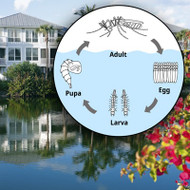


Midge Fly Reduction Study - Using Aeration, MuckAway PRO & PondClear PRO

The Challenge:
Due to poor water quality, the population of midge flies had become a big problem for residents in the Rio Pinar Home Owners Association in Orlando, FL. At 4,376 larvae/m2, a private consulting firm has measured the midge fly population at over 4 times the state nuisance level of 1,000 larvae/m2. Dense midge fly swarms were not only visually unappealing, but their excessive numbers also hindered outdoor activities, damaging vehicles and painted surfaces.
The Prescription:
To improve water quality and create an environment less conducive to midge fly reproduction, the Airmax team implemented a proactive pond care system consisting of
bottom diffused aeration and beneficial aerobic bacteria. An LS30 Airmax Aeration System would be installed, with all three plates distributed among the most profound areas of the lake, circulating the entire water column 1.3 times per day. PondClear PRO and MuckAway PRO beneficial aerobic bacteria would then be added to aid in the digestion of organic debris and mucK to reduce the living space of the midge fly larvae.
The Results:
Residents immediately saw improvements in water clarity and pond odors. With oxygen and organic-eating beneficial aerobic bacteria circulated throughout the entire pond, muck deposits were rapidly reduced, leaving midge fly larvae nowhere to hide. Natural predators to midge flies, like bluegill, breem, and aquatic beetles, could travel to lower depths and consume these larvae, lowering the population.
In only 10 months, the midge fly population was reduced by 84% to 723 larvae/m2; well below the set nuisance level.
